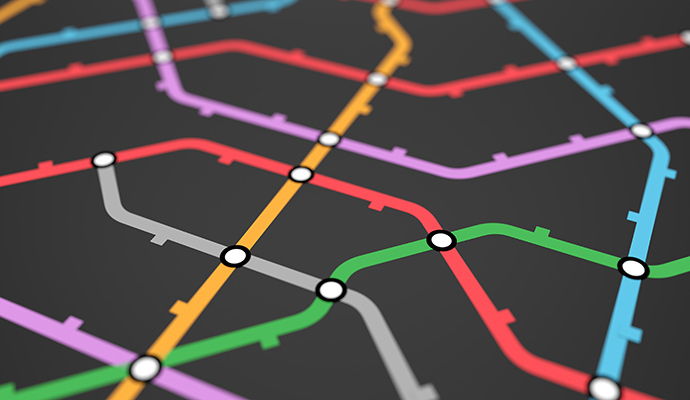How Neighborhood Disadvantage Drove COVID Health Disparities
Researchers found neighborhood disadvantage was linked with subway ridership during stay-at-home orders, acting as a proxy for understanding COVID health disparities.

Source: Getty Images
- When Daniel Carrión, PhD, MPH, a researcher from Mount Sinai, thinks of COVID-19 racial health disparities, he thinks of the subway. After all, needing to ride the subway—or work an essential job—are all strong links to the unequal infection rates seen during the height of the coronavirus pandemic, largely because it limits the ability to socially distance.
In new research, Carrión and his colleagues created a neighborhood-level COVID-19 inequity index for New York City, combining elements of social disadvantage like employment, commuting needs, population density, access to food, access to care, and socioeconomic status.
The researchers used these factors, plus Census data, to compare different neighborhoods and determine how each of these social factors influenced higher or lower rates of COVID-19 infection.
And, among other things, Carrión and team found a strong link between COVID-19 and the subway. Neighborhoods that ranked higher on the COVID-19 inequity index—meaning that neighborhood saw more factors that could put inhabitants at risk—also had higher subway ridership even after COVID-19 forced city-wide shutdowns.
“For us, subway utilization was a proxy measure for the capacity to socially distance,” Carrión, a postdoctoral researcher in the Department of Environmental Medicine and Public Health at the Icahn School of Medicine, told PatientEngagementHIT in an interview.
“Folks like me were able to stay home for the majority of the pandemic and work from home. I didn't need to use public transit whereas others did. What we found was that areas that had higher COVID inequity indices were also riding the subways more after the stay-at-home orders compared to folks that were low in the COVID inequity index.”
This was a critical finding, Carrión said, considering most of the prior literature related to COVID-19 racial health disparities. As far back as Spring 2020, data emphasized that Black and Latinx patients saw their disproportionate share of COVID-19 infections and deaths. Most of the conversation around this linked back to the social determinants of health and how structural inequity had led to more populations of color having chronic illness that exacerbated COVID-19 infection.
But that logic only explained why Black and Latinx people had worse outcomes once infected with the novel coronavirus, not why they were getting infected more often.
Although public health experts have made the link between the social determinants of health leading to actual infection, not just poor outcomes, Carrión and his colleagues put some data behind that. Social disadvantage was linked with higher subway utilization, and ultimately to higher infection rates and starker disparities.
And all of that fed into the racial disparities prominently discussed across the industry.
“We specifically excluded factors like race and ethnicity, because we wanted to see how much our index would reconstruct some of the racial disparities where we're seeing,” Carrión explained.
But when Carrión and the researchers looked at the racial composition of neighborhoods with various COVID-19 inequity indices, they found clear racial differences.
Black, Latinx, and Asian people were significantly more likely to live in neighborhoods with higher COVID-19 inequity indices, while White people were spread more evenly across different neighborhoods.
In other words, a White person would be just as likely to live in a low-index neighborhood as a middle- or high-index neighborhood. Black, Latinx, and Asian people were notably more likely to live in a high-index neighborhood.
“Indeed, Blacks and Hispanics and Latinx folks had lived on average in higher COVID inequity index neighborhoods,” Carrión noted.
And that could have consequences for the future, he added. As the US looks to design better public health response and pandemic preparedness—as well as get out of and ultimately recover from the crisis it’s currently in—it needs to consider equity and the structural issues that limit it.
“This speaks to the context of structural racism and how in order to think about pandemic preparedness in the future,” Carrión said. “Perhaps we also need to think about social and labor policy as part of a broader picture of pandemic preparedness, since it's clear that not everyone can observe stay-at-home orders equally by neighborhoods.”
And although Carrión is not necessarily an infectious disease expert, he did note that these issues can have consequences for how COVID0-19 can spread in the near-term. This comes as the US stares down the Delta variant and disparities in COVID-19 vaccination. While some parts of the country have reached near-widespread vaccination, there are still some big holes to patch up.
Carrión’s study didn’t look at nationwide trends, just New York City, and it used data from Spring 2020 long before we had the vaccine. But still, the data can speak to how the virus can spread unequally based on social disadvantage.
“There is broader literature out there that essentially says that when we have more equitable systems in play, that can benefit everyone,” he concluded. “An infectious disease process is such that it spreads. And so if we can find social and labor policies that protect more people, then that speaks to the not only the benefits with regard to health equity, but also for society more broadly.”
